Probably one of the biggest deterrents to an artist’s creative expression is the issue of storage. Questions frequently asked include: Where do I store the tools and materials of my craft? Where do I keep works that are in progress? Where do I keep finished inventory? While each artist has unique needs, depending on his or her craft, everyone shares a need to prevent clutter in the work space from derailing the creative process. At the same time, most artists fear too much organization will inhibit their productivity. In her book, Organizing from the Inside Out, Julie Morgenstern writes, “Many creative or ‘right-brained’ people who have always worked in chaos both crave and are frightened of getting organized.” The solution, of course, is a balance between utter chaos and complete orderliness.
Some simple household cleaning tips are probably helpful, as outlined in Organizing Plain & Simple, by Donna Smallin. According to Smallin, you should organize things in your life–in this case the tools and materials of your craft–according to these principles:
- Keep what you love
- Give away what you can’t use but somebody else can
- Throw away things no one wants and no one can use
- Sell things that will allow you to fuel your next shopping trip
- Put things away that aren’t where they need to be
That being said, storage for the typical artist remains a challenge. Very few artists are able to separate their work spaces entirely from the rest of the house.
“My current space is the worst,” says Joon of joonbeam. “I am in a small bedroom with ALL of our storage plus my supplies and work area. It’s like working in a closet. I only have three drawers in my art table. I need my sewing machine, paper cutter, ironing board, fabrics, notions, pens, scissors, threads, glues, crayons, paints, stamps, etc. ALL the time.”
Pam of bagsandmorebypam shares a similar issue. “I have probably 40 or more huge storage containers full of either yarn or finished products. These are in two different rooms: floor to ceiling in one end of one of our bedrooms, and almost one-third to one-half of the actual floor space in another bedroom where the computers and desk are.”
“Shelves! I need shelving!” says Brett of VanFleetStreetDesign. “I have things all over the place and things stored underneath my art table. I can’t even get my legs under it to sit. I put everything that I am not using on a daily basis downstairs in the spare bedroom.”

The issue of space need not be overwhelming, according to Julie Morgenstern. She says the key to effective storage is “to design your system to be simple, fun, and visually appealing so that it reflects your creative personality, and feeds it.”
Before you design that space, analyze your decorating style. Are you an Idealist? Adventurer? Leader? Guardian? In Organizing Your Craft Space, Jo Packham describes four decorating personalities, one of which will guide your choices in designing your crafting/storage areas. The Idealist likes a natural, simple setting that highlights the sentimental. Joon of joonbeam exemplifies this decorating style.
“I love to use tins, cans and pots for storage. One of my favorite storage solutions is this little hand painted Christmas tree box. I only have a few of this woman’s adorable painted boxes and this is the lone tree. She was an elderly woman and I found her items at a group guild shop.” The Idealist always has stories to tell about the items she uses to store things.
The Adventurer, on the other hand, enjoys an eclectic mixture of styles and colors, mixing modern and traditional furniture equally. Boldly painted walls of various colors are likely to be the mark of this type of decorating style. The pottery studio of Pearl of fehustoneware illustrates this style.
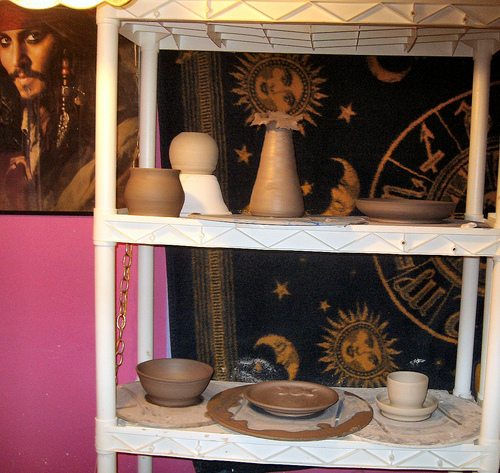
You’ll recognize the Leader by his or her use of stacks and rows of organized compartments. Likely Liv of thefiligreegarden has a Leader style of decorating. “Storing beads is rather easy,” she says. “I use stacks of clear, plastic boxes with compartments, organized by color, and metal versus glass. Even more convenient is the rolling beader’s case (like a suitcase on wheels) that I bought on clearance just before my craft shows. It has removable plastic boxes with sections for beads, and several zipped pockets that Velcro onto the inside of the front side where it zips open. I like the long, removable pocket which holds all my pliers and tools.”
The Guardian enjoys subtle lighting, rich wall color and antique furnishings. Kimberly of thewildhare probably has a blend of decorating styles in her space, among them the Guardian. “I have acquired, over the course of several years,” she says, “a variety of ‘antique’ containers that I store craft items in–watercolors, paint brushes, and stamps. They are scattered about my space, but make it convenient to keep things relatively organized.”
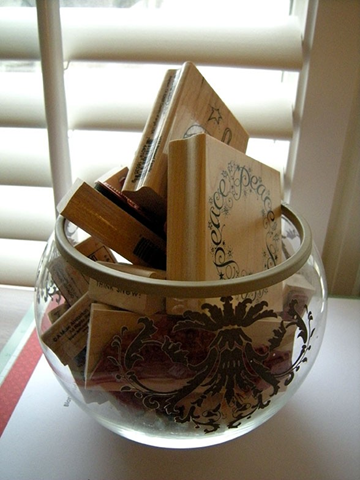
Still, no decorating style will solve issues that relate to specific crafts. Beth of BethPeardonProds, who specializes in photography, points out, “With photography storage is so important. Today everything is either stored on CDs on in your computer. Saving on CDs can be quite expensive since photos are huge files and a CD will hold so many. Leaving them on the computer leaves them very vulnerable to viruses, and if your computer crashes, so do they. So I have a storage drive that I keep my photographs in. I feel pretty confident that they are safe there. I’ve also lost photographs on CDs that have become scratched.”

Pat of onawhimsey, who creates encaustic works of art, says, “I have to remember that many of the tools I use are hot! So, I can’t just lay them down anywhere–for instance, the iron, hot stylus tool or my hot air gun. On my window sill I have a small hot plate which is stored there when not in use. On top I have a tile which works as a good insulator and safety layer for when I lay down my hot air gun (particularly the nozzle!), and I place the iron there in between the various applications.”

Pearl of fehustoneware, who needs a great deal of space to store her pottery, points out that “I have to stop throwing pots when I run out of room. It takes days for them to be dry enough to stack up, not to mention buckets of glaze.” In a perfect world, floor-to-ceiling shelves on every wall, with plastic over the front of them, would solve her storage challenge. “Oh, a real studio would be awesome!” Pearl adds.
Liv of thefiligreegarden, who designs jewelry, uses drawers, rolling carts and boxes to store beads and findings. Still, she could use more shelves and drawers to replace plastic shoe boxes and bead boxes that are stacked on wire shelving. “I have a rolling cart (about four feet tall) with drawers that contain stuff I use less often, along with surplus wire. I haven’t really solved the wire dilemma; I simply keep the various gauges in Ziploc bags marked with information about each one. But there are always stray pieces here and there.”
Kimberly of thewildhare, who designs needle felted rabbits, says that fiber storage is a new challenge for her. “I find that I am getting LOTS of it as I felt and spin. The fiber generally arrives in plastic bags of some sort, and these are nice for storing in general. However, you cannot keep fiber in a sealed bag; it has to be able to breathe.” Liv of thefiligreegarden agrees with Kimberly. “Soft, fibrous things don’t like to be contained!” Kimberly’s current solution for the fiber dilemma is a pair of large wicker baskets. “I keep the fiber for needle felting in one (along with a little box with needles and notions), and the fiber for spinning in the other. I keep the fibers in their plastics, but have opened the tops of each bag to permit air circulation.”
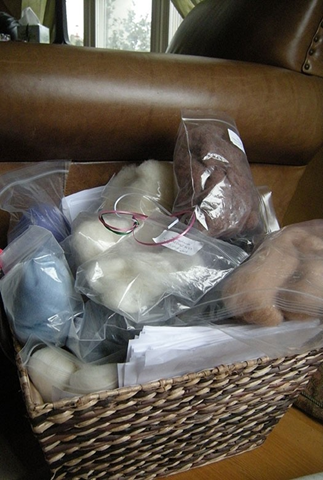
Pam of bagsandmorebypam says her biggest challenge is that as she buys more yarn, she has to buy more containers. “There is really no good way to organize them,” she points out, “and sometimes I have to unstack eight or ten to find what I need…either something that has sold or yarn for a specific project. My guess is that I have at least as many items finished as I have listed currently in my store, that haven’t even had photos taken yet. And tubs and tubs of yarn.” Pam believes that if she had a room the size of a two-car garage, with floor-to-ceiling shelves along three sides–along with a ladder to reach the highest shelves–this would solve most of her storage issues. She would use the fourth wall of such a room to hang mannequins that model her apparel for photography purposes, and a table with drawers or shelving beneath it to store her crochet hooks, knitting needles, fabric, books and notebooks.
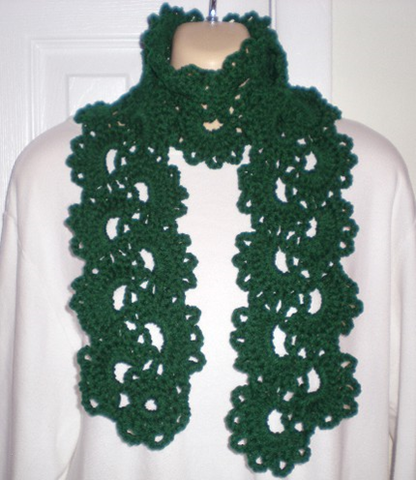
Despite the fact that Joon of joonbeam has a small bedroom in which she crafts, she has solved her challenge creatively. “I am lucky,” she says, “that we have a set of stainless steel restaurant shelves. Most of my tubs and boxes, etc. are stored on it.” She points out that she is adept at fitting in “an insane amount of anything in the smallest possible space.” She uses all kinds of storage containers for her crafting needs. These include file boxes, a flip-top tub, and tins, trays, baskets and drinking glasses for small supplies. She uses small vintage suitcases, and even purses and tote bags for storage. “I can’t say enough about Rubbermaid tubs,” she adds. “I adore them because you can see into them and they keep dust, pet hair and dirt out, they stack, they clip shut, they travel well. They’re reasonably priced and last forever.”
Joon points out that she loves to reuse anything and everything, which is often the attitude of many artists. “Necessity,” she says, “is the mother of invention.” A glass shelf suspended over two bar stools gives her much needed extra shelf space, as well as floor storage for her file boxes and baskets below. Even the rungs serve as storage caddies. The pen/scissor holder in the foreground is a stainless silverware caddy. The card table gives Joon extra space for small projects while solving the challenge of keeping her daily tools in close proximity.
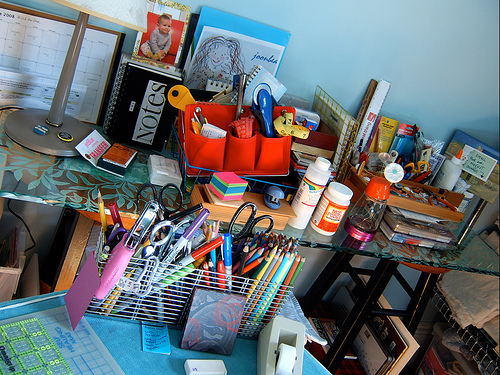
The crafting/storage space of all the BBEST artists in this post reflects their personalities and decorating styles. While none of them would claim they have enough space, they have made the most of what they do have. Meg Mateo Ilasco, the author of Craft Inc.: Turn Your Creative Hobby Into a Business, points out that whether your creative space is a desk, a closet, wall, spare room, garage, basement or a corner, it needs to reflect you. Since most artists work where they store their tools and materials, that means that their storage spaces need to be inspiring ones. Their storage space should include an “inspiration space” on the wall to post ideas or photos, good lighting, and ergonomic furnishings.
For more ideas about craft storage, consult the following resources:
- Craft Inc.: Turn Your Creative Hobby Into a Business, by Meg Mateo Ilasco
- Living the Creative Life: Ideas and Inspiration from Working Artists, by Rice Freeman-Zachery
- Organizing Your Craft Space, by Jo Packham
© 2009 Judy Nolan. All rights reserved. Please note that the images in this post are owned by the artists and may not be used without permission. Simultaneously published at http://boomersandbeyond.blogspot.com.



